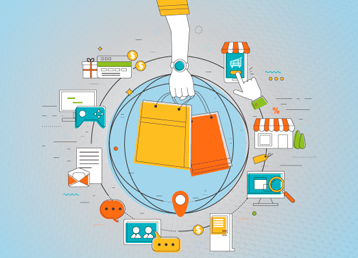Re-Imagining Data Visualization
Have you been distressed by dreary data? I have. At a point in time, it was frankly quite a daring task to keep up with information, for say, in a spreadsheet. Data was only limited for data-lovers who didn’t mind gazing at it without yawning. But now things have taken a creative twist. Data has, actually, become irresistible.
Since visuals receive 94% more viewership than text-based information, designers have changed the way data is presented. While visual marketing through infographics and presentations are generic categories now, designers all across the globe use innovative techniques to garner peoples’ interest and boost engagement through attractive data presentation. Thus, this practice has been concluded into an all-rounding term – “data visualization”.
Data Visualization
It is a kind of visual communication that is not limited to one industry. Data visuals are used to represent information regarding finance, fashion, music, beauty, design, and health etc. In fact, specialized degrees are offered to students who wish to take data visualization as a field of study or career. Considering that visuals have a high impact on human mind and emotions, designers use design elements so that data becomes:
Interactive
By using shapes and stylized fonts, you, the designer, enhance user interaction with data. People can now handle even big data since it’s become easier to swallow. Interactivity is not even available to the web or device rather than print only, because data onscreen is clickable.
Readable
It becomes easier for the viewer to spot trends and derive patterns. From business persons to a lay man, everybody can comprehend the flow of both quantitative and qualitative data. From printed financial reports to insights on web activity through analytics, data has become clearer.
Beautiful
Never thought that such an adjective would be suitable for describing data. Indeed, now it is. In a book Information is Beautiful by David McCandless, he has described how visual data combines fact with their connections, relationships and context — making information entertaining and meaningful.
So how do designers incorporate these three factors when visualizing data?
Visual Data Design
From the usual to the most unusual data, every piece of information is strategically laid onto a canvas. Information isn’t just technical, it is artistic as well because the human brain processes visual data 60,000 times faster than plain text.
Using creative data visualization techniques, you can make your data striking. The trick to 21st century data visualization is re-designing and re-imagining conventional visual and technical elements, according to what’s trending these days. For example flat design is popular these days, hence infographics are over-flowing with flat vectors rather than skeuomorphism.
Another trick to make data attractive is by creating humanizing designs. Adding elements which trigger emotional response or one’s that relate mundane objects that surround people. You can creatively reflect percentages, create rhythm and emphasize chunks of data.
Check out visual techniques that’ll uplift your data.


